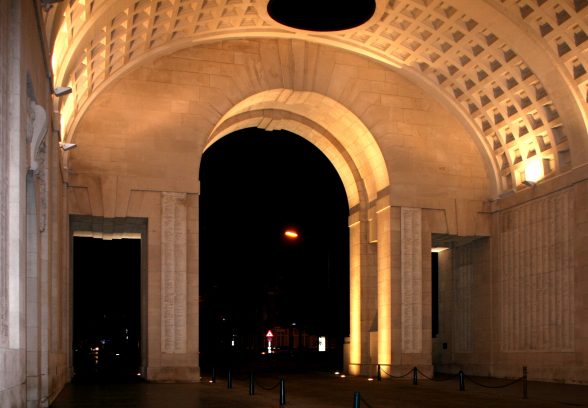This website uses cookies
This website uses cookies to enable it to function properly and to analyse how the website is used. Please click 'Close' to accept and continue using the website.








Belgium: The Menin Gate, Ieper
Architect: Sir Reginald Blomfield
Owners: Commonwealth War Graves Commission
Location: Ieper, West-Vlaanderen
In 1919, Sir Reginald Blomfield was invited to visit and survey Ypres to find a site for a large British war memorial. He recommended the site of the Menin Gate, the former Antwerp Gate, where the road east left the city centre, passed between the remains of the ramparts and crossed the Citadel Moat – a road along which so many British troops had passed on their way to battle. Once there had been a gateway here by the French military engineer Vauban, erected when Ypres had temporarily been annexed by Louis XIV. Blomfield proposed a “triumphal archway”. Vauban was a hero of Blomfield’s, and his design, to be executed in red brick and white stone, was inspired by the 17th century Porte de la Citadelle at Nancy. Triumphal arch elevations in Roman Doric faced both east and west while internally he proposed a large hall covered by an elliptical vaulted ceiling. In 1921, the National Battlefields Memorials Committee was dissolved and the IWGC undertook the task of erecting Memorials to the Missing, and as it made no sense to erect two large memorials in Ypres, the Menin Gate memorial project became a Memorial to the Missing. Eventually the walls of the Hall of Memory, together with the walls facing the ramparts behind colonnades, were inscribed with 54,896 names. Comparatively little change was made to Blomfield’s 1919 design. Originally he proposed vaulting the hall in brick, but was persuaded that this would make the interior too dark and the executed vault is of reinforced concrete. Also, the first design envisaged spiral staircases at each corner rising to the level of the ramparts, but Blomfield happily adopted the suggestion of the City Architect, Jules Coomans, that there should instead be two lateral staircases rising from the centre of the hall. Fortunately perhaps, Blomfield failed to persuade the city that the Meensestraat leading to his memorial should be widened to show it off better.
Work began on the Menin Gate in 1923 and it was unveiled four years later in 1927 by Lord Plumer. For Blomfield, the Menin Gate was one of three works he wanted to be remembered by, “perhaps the only building I have ever designed in which I do not want anything altered.” It was the first and most important of the British Memorials to the Missing to be completed and it was to become the best known. Perhaps it is also the memorial in which a certain bombastic air is most evident, especially with the massive lion on the outward-facing eastern parapet modelled by the sculptor William Reid Dick. This, Blomfield wrote, is “not fierce and truculent, but patient and enduring, looking outward as a symbol of the latent strength and heroism of our race.”
The Menin Gate was damaged during the fighting in 1940 – the principal damage being caused by the retreating British Army which blew up the bridge across the moat. The memorial was restored in 1945-48 by Blomfield’s son Austin Blomfield. In the evening, the ‘Last Post’ is played at the Menin Gate by a volunteer Belgian bugler. This ceremony has been performed every evening since 1928 except during the German occupation during the Second World War.
Gavin Stamp
Commonwealth War Graves Commission
Either enter the name of a place or memorial or choose from the drop down list. The list groups memorials in London and then by country

Become a C20 member today and help save our modern design heritage.